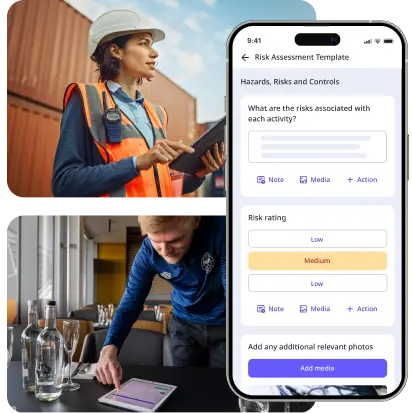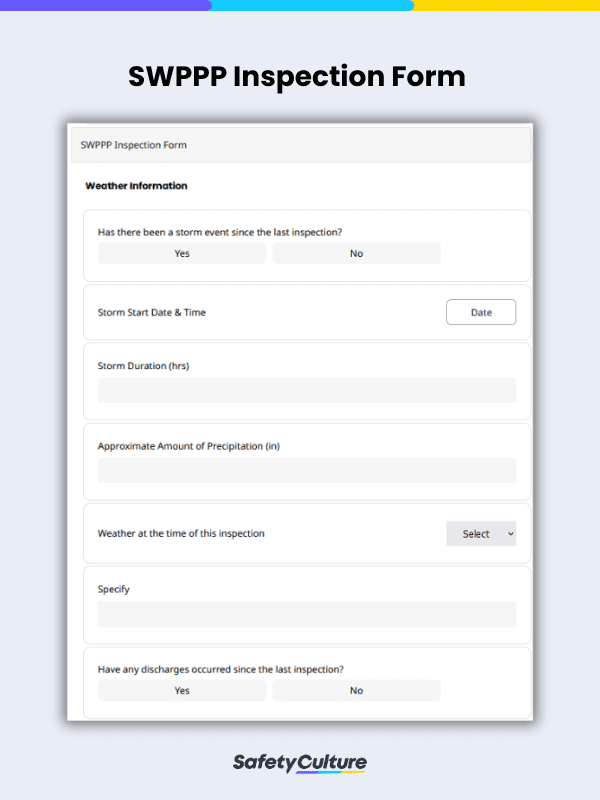What is SWPPP Inspection?
SWPPP inspection, also known as a stormwater inspection, is the process of verifying the implementation of a stormwater pollution prevention plan (SWPPP) in a construction site. The U.S. Environmental Protection Agency (EPA) National Pollutant Discharge Elimination System (NPDES) requires construction site operators to regularly inspect if the best management practice (BMP) for reducing pollutants in stormwater discharges is installed and maintained.
What is an SWPPP Checklist and Why is It Important?
An SWPPP checklist is a tool used by construction area managers, local government authorities, and third-party stormwater inspectors to record SWPPP performance, rectify violations, and ultimately, demonstrate compliance with the Clean Water Act (1972). Noncompliance can lead to the issuance of a stop work order (SWO), litigation, and negative media coverage, damaging the image and reputation of operators and contractors.
This article will briefly discuss: 1) the impact of making stormwater inspections more efficient; 2) common compliance problems at construction sites and how to solve them; 3) an inspection and corrective action solution to help you execute BMPs; and 4) free SWPPP inspection forms you can download, customize, and use.
The Impact of Stormwater Inspections
Water contamination can turn a thriving community into a ghost town, affecting thousands of people, and its effect can last for generations. Hinkley, or the ‘Erin Brockovich’ town, is still suffering from the actions of Pacific Gas and Electric Company (PG&E) who dumped cancer-causing contaminants into an unlined wastewater pond for 14 years. Regular stormwater inspections can help prevent future instances of negligence and protect the health of workers and civilians alike.
Common Stormwater Inspection Problems and How to Solve Them
In February 2020, three Massachusetts construction companies were fined a total of $23,220 for noncompliance with stormwater regulations such as failing to obtain, adhere to, and document inspections required by their stormwater permits. Operators and contractors should take responsibility for their actions by reducing pollutants in stormwater discharges. According to the EPA, here are solutions to the common violations during SWPPP inspections:
Poor Sediment Controls
Sediment control practices on down-gradient perimeters should be established before up-gradient land disturbance begins. BMPs include sediment basins, sediment barriers, and dam checks. Moreover, temporary stockpiles should also have a silt fence to retain sediment that has been dislodged by stormwater, and vehicle tracking on the road should be minimized by using stone pads and concrete or steel wash racks.
Missing Temporary or Permanent Cover
If any construction activity has temporarily or permanently ceased on any portion of the site and will not resume for a period exceeding 14 calendar days, then all exposed soil areas should have stabilization initiated immediately to limit soil erosion. To solve this compliance problem, install and maintain the following best management practices:
Temporary BMPs:
- Temporary seeding
- Mulches
- Matrices
- Blankets and mats
- Soil binders
Permanent BMPs:
- Permanent seeding and planting
- Sodding
- Channel stabilization
- Vegetative buffer strips
No Inlet Protection
Before construction begins, all storm drain inlets that receive a discharge from the site must be protected and maintained until the site is stabilized. Inlet protection may be removed when safety issues are detected, and written correspondence should be documented in the SWPPP. Design the inlet protection with the appropriate size, handling the volume of water from the area being drained adequately.
Improper Solid Waste or Hazardous Materials Management
Solid waste should be disposed of properly, and implementing the site waste management plan (SWMP) mitigates the impact of waste to stormwater discharge, eventually preventing the contamination of clean water sources. Hazardous materials, including oil, gasoline, and paint, should also be stored properly.
Incorrect De-watering and Concrete Washout
Where building footings are being constructed, enforce de-watering measures that ensure the pumped discharge is not causing erosion. Never discharge muddy water into storm drains, streams, lakes, or wetlands unless the sediment has been removed before discharge. Designate specific washout areas and design facilities to handle anticipated washout water. EPA recommends that they are located at least 50 yards away from storm drains and watercourses whenever possible.
What should be Included in a SWPPP Checklist
A Stormwater Pollution Prevention Plan (SWPPP) checklist should include items that will thoroughly detail all what’s needed to oversee the project completion and documents required by compliances and regulations. Here are the key components that should be included when creating a SWPPP checklist:
- Contact Information: Name, address, phone, and email of the owner and contractor.
- Project Details: Basic site information, including location, project status, size, and area of disturbance.
- Permits: Proof of existing coverage under applicable permits, such as the State Water Board’s Construction General Permit.
- Certification: The SWPPP must be developed and certified by a Qualified SWPPP Developer (QSD).
- Water Bodies: Identification of proximity to water bodies, especially those impaired by sediment-related pollutants.
- Risk Level: Identification of the site’s risk level as per the requirements in the Construction General Permit.
- Best Management Practices (BMPs) : BMP must be designed by a licensed engineer and include measures for sediment and erosion control, tracking prevention, spill prevention, and waste management protocols (like concrete washout and sanitary waste). These practices ensure comprehensive management of site conditions and minimize environmental impact.
When using a digital checklist like SafetyCulture, you can generate a report to summarize what needs to be worked on and assign them immediately




